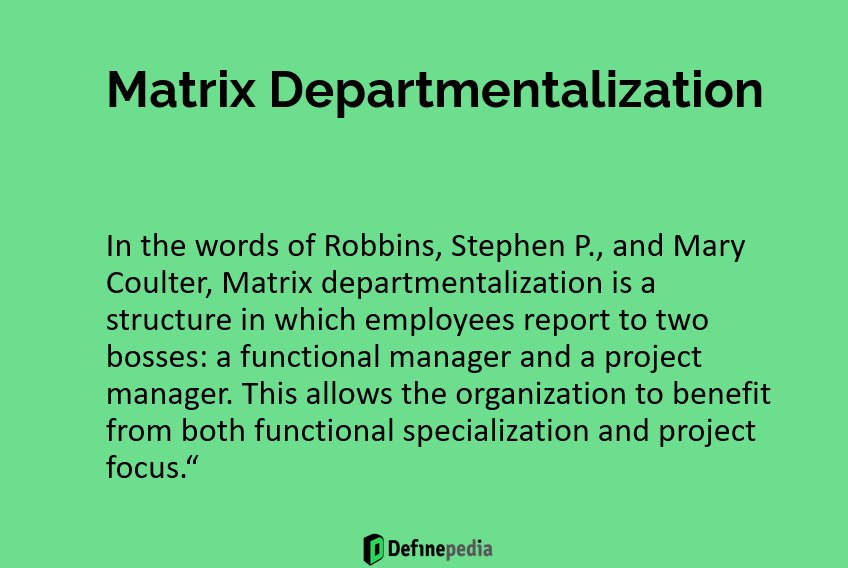Matrix departmentalization is a dynamic organizational structure that aims to combine the strengths of functional and task force (project) departmentalization designs. This approach seeks to enhance coordination among various components within an enterprise, particularly for complex activities such as space missions, film productions, and military operations.
By harmonizing different functional areas, matrix departmentalization strives to achieve economies of scale, improve customer service, and foster flexibility. In this section, we delve into the definition, advantages, disadvantages, implementation challenges, and best practices of matrix departmentalization.
Matrix departmentalization is a sophisticated organizational structure that seamlessly blends the best of functional and project-based designs. This fusion aims to optimize coordination for singular activities, capitalize on economies of scale, and elevate customer and company satisfaction.
Originating in the early 1960s as a response to the escalating complexity and size of technically-driven enterprises, matrix departmentalization found traction in notable companies such as Dow Coming, General Electric, and Shell Oil.
This innovative structure introduces dual supervision, encompassing both technical and administrative managers. It weaves together multiple reporting systems and communication lines to facilitate informed decisions.
However, potential challenges highlighted by Davis and Lawrence include the risk of anarchy due to dual reporting, power struggles, and financial strain during economic downturns.
These concerns can be effectively addressed through clear role definitions, authority delineation, and the appointment of experienced managers who prioritise knowledge-based influence over rank.
Matrix departmentalization structure adoptive seamless communication across various organizational departments, nurturing resource-sharing and employee development.
Yet, it’s important to acknowledge potential drawbacks such as employee confusion stemming from reporting to multiple superiors and increased workloads due to enhanced collaboration. Organizations should anticipate supplementary expenses associated with implementing the necessary mechanisms to support matrix operations.

Definition of Matrix Departmentalization
“Matrix departmentalization is a structure in which employees report to two bosses: a functional manager and a project manager. This allows the organization to benefit from both functional specialization and project focus.”
Robbins, Stephen P., and Mary Coulter
Matrix departmentalization emerged in response to the escalating complexity and size of technically oriented enterprises during the early 1960s.
Initially embraced by the aerospace industry and later adopted by corporate giants like Dow Coming, General Electric, and Shell Oil, this concept intertwines a project management structure with a traditional functional organization.
This approach involves a dual supervision system, encompassing both technical and administrative managers, and introduces multiple reporting systems to facilitate decision-making.
How Matrix Departmentalization Works
In the matrix organizational structure, functional areas coexist under the direct control of the CEO. These functional areas, which could include Purchase, Logistics, HR, Engineering, and Finance, are responsible for overseeing crucial projects vital to the organization’s survival.
This Interplay of Differences of functions and projects underlines the matrix’s central tenet—harmonizing diverse aspects for the benefit of the entire organization.
Advantages of Matrix Departmentalization
Matrix departmentalization offers numerous advantages that contribute to its appeal:
- End Result Orientation: This structure emphasizes achieving desired outcomes, fostering a goal-driven environment.
- Professional Identification: Individual expertise is highlighted, creating opportunities for personal growth and specialization.
- Pinpointed Product-Profit Responsibility: Accountability is clearly defined, making it easier to track and attribute successes or challenges.
Disadvantages of Matrix Departmentalization
However, matrix departmentalization is not without its challenges:
- Conflict in Authority: Dual reporting relationships can lead to ambiguity in reporting lines and decision-making responsibilities.
- Potential Disunity of Command: Multiple managers may lead to confusion among employees, impacting productivity and cohesion.
- High Managerial Expectations: Managers must excel in both technical and administrative roles, requiring a diverse skill set.
Challenges in Matrix Departmentalization
Matrix organizations, while promising, can encounter several problems:
- Tendencies towards Anarchy: Dual reporting can create confusion and a lack of clear leadership.
- Power Struggles: Ambiguity in career paths can lead to struggles for power and upward mobility.
- Severe Grouping: Decision-making can be hampered by excessive group involvement, slowing down processes.
- Collapse during Economic Downturns: The matrix structure may be discarded during tough times due to perceived inefficiencies.
- Excessive Overhead: Initial implementation can incur high costs, although these may be offset by eventual gains.
Best Practices for Implementing Matrix Departmentalization
To maximize the benefits of matrix departmentalization, consider these guidelines:
- Clear Objectives: Define project or task goals clearly.
- Role Clarity: Clearly delineate roles, authority, and responsibilities for both managers and team members.
- Influence based on Knowledge: Decision-making should be grounded in expertise, not just rank.
- Balance of Power: Ensure equitable power distribution between functional and project managers.
- Team and Organization Development: Invest in team cohesion and overall organizational development.
- Experienced Leadership: Appoint experienced managers to lead projects effectively.
- Fair Rewards: Recognize and reward project managers and team members fairly.
Measuring Success and the Future of Matrix Departmentalization
Assessing the effectiveness of matrix departmentalization involves evaluating its impact on productivity, coordination, and efficiency. As organizations continue to evolve, trends in matrix departmentalization may highlight increased collaboration, technological integration, and adaptability. By learning from both successes and challenges, businesses can navigate the complexities of this organizational model more effectively.
My Perspective
In summary, matrix departmentalization emerges as a strategic amalgamation of functional and project-based structures, strategically aligned to optimize organizational components. While presenting distinct advantages, careful deliberation and skilled execution are imperative due to potential challenges. As industries and businesses continue their evolution, the matrix approach stands as a pivotal instrument for attaining multifaceted and ever-changing objectives.
The matrix departmentalization model provides a dynamic synergy of adaptability, collaboration, and efficient resource utilization. Organizations venturing into this realm must approach it with equilibrium. By nurturing role clarity, selecting adept managers, and fostering a culture of knowledge-driven leadership, the expedition into matrix departmentalization can harmonize into a symphony of triumph, avoiding the dissonance of obstacles.
Leave a Reply